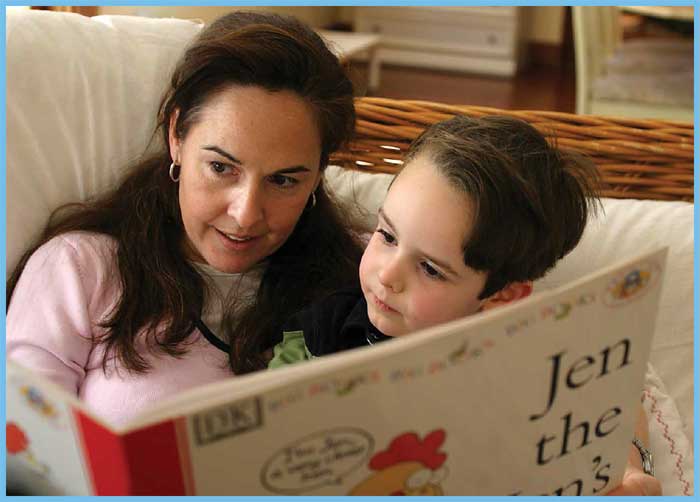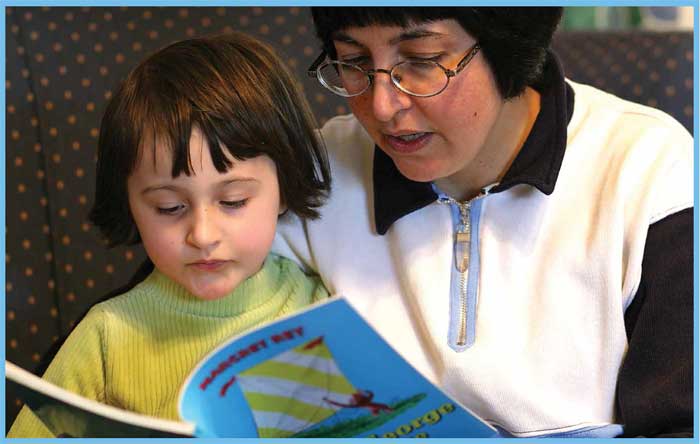How Grandparents Can Help a Child Struggling With Reading
Strategies every parent needs to know
The following strategies work for young children through to adults. The only divergence is the book selection of the reader.
These strategies are useful when children choose books beyond their instructional levels. They choose books they want to read but equally nonetheless, cannot read them independently. Before introducing these strategies, it is ever all-time to allow the reader to read for a few minutes while monitoring the miscues. After a few minutes of reading aloud, and when a pattern in the miscues indicates that meaning is lost and reading is laboured, show the reader any of the following strategies. I usually introduce echo and shared together and and so ask the reader to choose. These strategies are not hierarchical. They all offer layers of back up to give the reader access to the book of his/her option. Think, the reader always holds the book.
Echo reading
Repeat reading is simply, parent reads a sentence, paragraph or page (depending on the text) and the child repeats it back. Before starting, negotiate with the child to read a judgement, paragraph or page. The parent reads first. The child re-reads (echoes) the sentence, paragraph or page. Go on in this way to consummate the book. Echo reading eliminates the frustration and feet that is too often associated with reading aloud. It often happens that once the child becomes confident with the book, author's fashion, and language, he or she does non stop for the parent to take a plough — ultimately, that is the goal — independence. If it does not happen that the child takes over, repeat reading is effective. By 'echoing' your reading, the kid has an opportunity to sound like a fluent reader. This is important in building a child'due south sense of what information technology feels like and sounds like to be a proficient reader. The child feels confident, relaxed and enjoys the experience. It is most comprehension and having fun with a adept volume. During echo reading, parents model skillful reading. When parents miscue, they share the experience. This allows the child to see that all readers make miscues and self-right.

Shared reading
With shared reading, the parent reads, the kid reads. They take turns to read. The parent negotiates with the child to read a sentence, paragraph or page depending on the book. When the parent reads, any loss of meaning, misunderstandings or mispronunciations that have been fabricated past the kid are rectified without cartoon attention to the child's miscues. When the child comes to unfamiliar words, he/she will hear it read correctly past the parent and will automatically cocky-correct the next time the word appears. Shared reading ensures that comprehension is maintained. Shared reading eliminates the frustration of reading because the parent is a partner in the reading of the selected text.
Neurological Print Method (NIM)
The kid reads aloud 'mimicking' the words of the text as the parent reads aloud. The child reads a couple of words backside the parent. The parent tracks with a finger so the child tin go on upwardly. It is important to avoid word pointing – instead, the parent's finger moves across the line in a fluid movement. The simply reason, the parent tracks is because children get distracted and when they drop dorsum into the reading, they know where the parent is reading. The parent reads at a normal reading footstep. When the child looks away from the book, the parent does not end reading. Continue with enthusiasm and the kid will render to the book. When using NIM, the child has an opportunity to sound similar a fluent reader. This is important in building a child'southward sense of what it feels like and sounds like to be a good reader. The child sounds like a fluent reader and builds confidence and trust. In that location is no stress and malaise.
Paired reading
Paired reading is an effective support for readers who ignore punctuation, read in a monotone, and/or extremely quickly or slowly. It is besides a good strategy when children choose to read their favourite book for the 55th time. Just read it together and love it one more time. Paired reading is simply reading together at the same pace and in the aforementioned place. The parent reads in a normal reading voice. Information technology usually takes a couple of sentences for both readers to autumn into sync. It is like dancing with a partner and it might feel a piddling awkward until a common rhythm and rhyme are reached. The child holds the book, turns the pages and enjoys the time together.

Learning to write
What nosotros need to know
Children experiment with writing long earlier they start school. Their early on squiggles and drawings are the showtime of writing.
Books provide a powerful model of what writing looks like. Books convey the agreement that squiggles on a page convey a message. Reading and writing with your children helps them to make sense of how written language works.
We larn to write by writing. Children dearest to write! In classrooms, children are encouraged to select topics that limited their ideas and interests. It is hard (sometimes incommunicable) to write most unfamiliar topics or topics that are irrelevant to our life experiences. Before writing, talking virtually a topic is a good identify to collect thoughts and ideas.
When children write and freely express their ideas, this is called draft writing. Children need many opportunities to express their thoughts and ideas in writing without beingness concerned nearly the mechanics of writing such a spelling, punctuation and grammar. At this stage, worrying about spelling, punctuation and grammar tin hinder their styles, expressions and exploration of words that best communicate their ideas. In fact, this level of response oft 'kills' off the writer who learns to write less and take fewer risks. Instead, respond to the ideas of the writer – for case, ask: Where did yous become your idea? Are yous writing a factual text (poem, recipe, chapter book etc)? What is going to happen next? Read me your pb sentence again because that actually had me interested in your story. What is going to happen to your main character?
If the draft writing is to be shared with a wider audience, and has been edited for meaning, the next stage is to proofread for spelling, punctuation and grammatical mistakes. Not all writing needs to be edited. We do not edit our shopping lists, diaries or reminder notes! Children need to exist encouraged to write for enjoyment and play with words.
In classrooms, children explore writing as a process from drafts to published pieces. Children are encouraged to write for real purposes and use a range of dissimilar text types such every bit recipes, factual texts, notes, report writing, narratives and verse. They are likewise taught to consider how to appeal to different audiences.
Handwriting should non be confused with writing. Handwriting is a surface feature of writing and children who are self-witting of their handwriting benefit from opportunities to write and draw with a multifariousness of pens, textas, pigment, magic boards, chalk and 'fancy' pencils. When it comes to publishing, children often publish on the calculator, apply vocalism to text recognition or publish in a variety of ways such a affiche, alphabet books, dioramas, or affiliate books. The form the publishing takes is the all-time friction match for the type of story existence told.
Work that comes home from school may non accept every spelling error corrected, every grammatical error rectified or punctuation inserted. It is important to talk with your children nearly the purpose of the work and what they learned, rather than emphasise the errors. Ask 'tell me questions' such as: 'Tell me about this work …' 'Tell me how yous did this …' 'Tell me what you liked virtually this activeness.'
How Grandparents Can Help a Child Struggling With Reading
Source: https://www.petaa.edu.au/w/teaching_resources/parents_guide.aspx